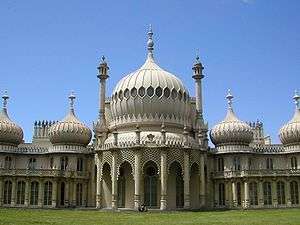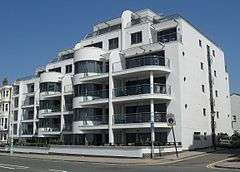Royal Albion Hotel
| Royal Albion Hotel | |
|---|---|
.jpg) The eastern façade of the hotel | |
 Location of the hotel within central Brighton | |
| General information | |
| Location |
35 Old Steine, Brighton, Brighton and Hove BN1 1NT, |
| Coordinates | 50°49′11″N 0°08′14″W / 50.8197°N 0.1373°WCoordinates: 50°49′11″N 0°08′14″W / 50.8197°N 0.1373°W |
| Opening | 5 August 1826 |
| Owner | Britannia Hotels Ltd |
| Management | Britannia Hotels |
| Technical details | |
| Floor count | 4 |
| Design and construction | |
| Architect | Amon Henry Wilds |
| Developer | John Colbatch |
| Other information | |
| Number of rooms | 195 |
| Number of restaurants | 1 |
| Parking | 0 |
| Website | |
|
www | |
The Royal Albion Hotel (originally the Albion Hotel) is a 3-star hotel in the seaside resort of Brighton, part of the English city of Brighton and Hove. Built on the site of a house belonging to Richard Russell, a local doctor whose advocacy of sea-bathing and seawater drinking helped to make Brighton fashionable in the 18th century, it has been extended several times, although it experienced a period of rundown and closure in the early 20th century. A fire in 1998 caused serious damage, but the hotel was restored.
The Classical-style building is in three parts of different sizes and dates but similar appearances. Large pilasters and columns of various orders feature prominently. Amon Henry Wilds, an important and prolific local architect, took the original commission on behalf of promoter John Colbatch. Another local entrepreneur, Harry Preston, restored the hotel to its former high status after buying it in poor condition. The building took on its present three-wing form in 1963. The original part of the building was listed at Grade II* by English Heritage for its architectural and historical importance, and its western extension is listed separately at the lower Grade II.
History
Beginnings
The site itself is connected with the life and career of Richard Russell, a doctor who advocated sea water as a cure of ailments. After Russell's death in 1759, Old Steine developed as the centre of fashionable life in Brighton.[1] Russell House, as it became known, was used as lodgings for visitors such as the Duke of Cumberland, and later became an entertainment venue with activities such as a puppet theatre, a camera obscura and resident jugglers.[2][3]
In the 1820s, it passed to entrepreneur John Colbatch, who demolished it in 1823. The local authorities tried to arrange for the land to be kept as open space, but negotiations collapsed and Colbatch began planning the construction of a hotel.[2][3]
Construction, success, disrepair
.jpg)
Colbatch commissioned young architect Amon Henry Wilds, who began planning the hotel in 1822.[3] Wilds, the son of Amon Wilds and an associate of Charles Busby, had been responsible for many building schemes in Brighton from about 1815, when he and his father moved their architectural practice to Brighton. Schemes already completed by 1822 included King's Road and Brighton Unitarian Church.[4][5] The hotel was built on a corner site at the point where Old Steine met King's Road, and like Russell House the main façade faced away from the sea, towards Old Steine.[6] The four-storey structure opened on 5 August 1826.[3][7][8]
The venture was immediately successful, and a stylistically similar five-storey extension was added to the west in about 1847. At the same time, the name was changed from the Albion Hotel.[6] Six years earlier, one of Brighton's most important cultural establishments was established in a ground-floor room: the Albion Rooms Literary and Scientific Institution combined the functions of library, lecture theatre and museum. The venture eventually became unsustainable, and the institution's members presented the accumulated books, artefacts and pictures to Brighton Corporation, the local authority. This led to the establishment of the Brighton Museum and Art Gallery and Brighton Library in the grounds of the Royal Pavilion.[9]
The hotel fell into disrepair in the late 19th century, and was closed in 1900. Harry Preston, owner of the nearby Royal York Hotel, bought it in 1913 for £13,500 (£1,219,000 in 2018),[10] and quickly restored its fashionable reputation. The building was completely refurbished, additions were made, and well-known literary figures, artists and entertainers regularly stayed.[7][11] The extensions carried out around this time, in the Edwardian style typical of the period, included a sea-facing lounge at the rear of the hotel, and were carried out by Brighton architectural firm Clayton & Black.[6] Started in the 1870s by Charles Clayton and Ernest Black and continued by their sons, this firm was one of Brighton's most prolific designers of public buildings and churches over the next 60 years.[12]
In 1856, another hotel had been built west of the Royal Albion on land previously occupied by Williams's Royal Hot and Cold Baths, an indoor bath-house.[13] The Lion Mansion Hotel was architecturally similar to the Royal Albion, and rose to four storeys.[6][14] It was later known as the Adelphi Hotel.[14] In 1963, it was taken over by the Royal Albion, and became physically linked to it as a west wing.[6]
Fire
On the morning of 24 November 1998, the hotel was devastated by a fire which started in the kitchen. A chef was frying eggs and sausages in a pan; hot fat spilt and caught light,[15] and flames were immediately sucked up a vent to the top floor. The fire spread quickly, assisted by strong winds, and all 160 people in the building were evacuated.[15][16] The Public and Commercial Services Union had to cancel their annual conference, due to be held that day, because of the disruption caused to its delegates, most of whom were staying at the hotel.[16] About 160 firefighters from all parts of East and West Sussex attended the fire from about 8.20am until late in the evening, in what was later described as Brighton's "biggest firefighting operation for nearly 30 years".[15] All parts of the hotel were affected by smoke, water and structural damage, but the original corner building was particularly badly affected.[15]
Architecture
.jpg)
In its present form, the Royal Albion Hotel is in three linked sections, all stylistically similar. The original (eastern) wing is four storeys tall and has five extremely large Corinthian and Composite columns on the north face. These are flanked on both sides by large pilasters, which also run all round the east face.[6][17] The top floor is an attic storey displaying Wilds's characteristic motif: shell designs set in blank rounded tympana.[6][17][18] Above this is a mansard roof, now mostly obscured.[8] The centre section, dating from about 1847, has three full storeys and two attic floors above, and is therefore taller.[18] The façade has three bays. The theme of large pilasters and columns continues, but different styles are used: the left and right bays project slightly and have paired Tuscan pilasters,[8] and a pair of tapering Ionic columns in the centre bay form a distyle in antis composition.[6][18] The centre section also has a mansard roof—apparently a later addition.[8] The western wing (the former Lion Mansions) has a Tuscan-columned porch on the south (seafront) side and a Doric-style equivalent facing north to Old Steine, four Composite pilasters extending for three of the four storeys, small cast-iron balconies and some aedicula-style window surrounds.[14][17]
Present day
The Royal Albion Hotel was listed at Grade II* on 13 October 1952.[18] Such buildings are defined as being "particularly important ... [and] of more than special interest".[19] In February 2001, it was one of 70 Grade II*-listed buildings and structures, and 1,218 listed buildings of all grades, in the city of Brighton and Hove.[20] The west wing (the former Lion Mansions) was listed at Grade II on 5 August 1999.[14] In February 2001, it was one of 1,124 buildings listed at that grade in Brighton and Hove;[20] the status indicates that the building is considered "nationally important and of special interest".[19]
The hotel is operated by Britannia Hotels. There are 208 guest rooms, one restaurant, two bars and five rooms for conferences and meetings.[21] Bedrooms are classified in four grades, from standard to deluxe.[22] It has a 3-star rating.[23]
See also
References
Notes
- ↑ Carder 1990, §114.
- 1 2 Carder 1990, §164.
- 1 2 3 4 Musgrave 1981, p. 216.
- ↑ Berry 2005, p. 157.
- ↑ Berry 2005, p. 182.
- 1 2 3 4 5 6 7 8 Antram & Morrice 2008, p. 69.
- 1 2 Carder 1990, §160.
- 1 2 3 4 Brighton Polytechnic. School of Architecture and Interior Design 1987, p. 79.
- ↑ Musgrave 1981, pp. 216–217.
- ↑ UK Retail Price Index inflation figures are based on data from Clark, Gregory (2017). "The Annual RPI and Average Earnings for Britain, 1209 to Present (New Series)". MeasuringWorth. Retrieved 6 November 2017.
- ↑ Musgrave 1981, p. 217.
- ↑ Antram & Morrice 2008, p. 23.
- ↑ Musgrave 1981, pp. 201–202.
- 1 2 3 4 "Detailed record: Western wing of the Royal Albion Hotel, Grand Junction Road (north side), Brighton". Images of England. English Heritage. 2007. Retrieved 4 February 2010.
- 1 2 3 4 "Bangers and flash". The Argus. Newsquest Media Group. 25 November 1998. Archived from the original on 5 May 2013. Retrieved 4 February 2010.
- 1 2 "Fire rips through hotel". BBC. 24 November 1998. Retrieved 4 February 2010.
- 1 2 3 Nairn & Pevsner 1965, p. 446.
- 1 2 3 4 "Heritage Gateway Listed Buildings Online — The Royal Albion Hotel and attached walls, piers and railings, Old Steine (south side), Brighton". Heritage Gateway website. Heritage Gateway (English Heritage, Institute of Historic Building Conservation and ALGAO:England). 2006. Retrieved 4 February 2010.
- 1 2 "Listed Buildings". English Heritage. 2010. Archived from the original on 24 January 2013. Retrieved 26 August 2011.
- 1 2 "Images of England — Statistics by County (East Sussex)". Images of England. English Heritage. 2007. Archived from the original on 27 December 2012. Retrieved 27 December 2012.
- ↑ "Royal Albion Hotel Brighton". Britannia Hotels Ltd. Retrieved 3 October 2014.
- ↑ "Royal Albion Hotel Brighton: Bedroom Descriptions". Britannia Hotels Ltd. 2010. Retrieved 4 February 2010.
- ↑ "Royal Albion Hotel – Brighton". Hotels.com L.P. 2002–2010. Retrieved 4 February 2010.
Bibliography
- Antram, Nicholas; Morrice, Richard (2008). Brighton and Hove. Pevsner Architectural Guides. London: Yale University Press. ISBN 978-0-300-12661-7.
- Berry, Sue (2005). Georgian Brighton - Phillimore & Co. Chichester. ISBN 1-86077-342-7.
- Brighton Polytechnic. School of Architecture and Interior Design (1987). A Guide to the Buildings of Brighton. Macclesfield: McMillan Martin. ISBN 1-869865-03-0.
- Carder, Timothy (1990). The Encyclopaedia of Brighton. Lewes: East Sussex County Libraries. ISBN 0-86147-315-9.
- Musgrave, Clifford (1981). Life in Brighton. Rochester: Rochester Press. ISBN 0-571-09285-3.
- Nairn, Ian; Pevsner, Nikolaus (1965). The Buildings of England: Sussex. Harmondsworth: Penguin Books. ISBN 0-14-071028-0.
External links
| Wikimedia Commons has media related to Royal Albion Hotel, Brighton. |

.jpg)
.jpg)
